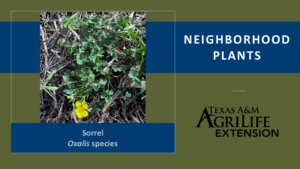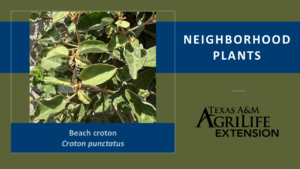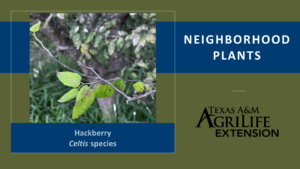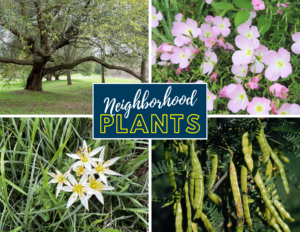 Neighborhood Plants Video Series brings the rangelands to your neighborhood! Each month, we’ll bring you new videos to help you explore the diversity of Texas plants from your own “backyard”. Check back often to see what’s in bloom and learn how to identify these Texas plants!
Neighborhood Plants Video Series brings the rangelands to your neighborhood! Each month, we’ll bring you new videos to help you explore the diversity of Texas plants from your own “backyard”. Check back often to see what’s in bloom and learn how to identify these Texas plants!
JANUARY
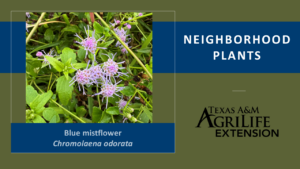 Blue Mistflower – a native perennial subshrub that is found growing across neighborhoods and rangelands. Blue mistflower is a valuable food resource for many pollinators. The seeds are consumed by granivorous birds, and the plant is browsed on by wildlife.
Blue Mistflower – a native perennial subshrub that is found growing across neighborhoods and rangelands. Blue mistflower is a valuable food resource for many pollinators. The seeds are consumed by granivorous birds, and the plant is browsed on by wildlife.
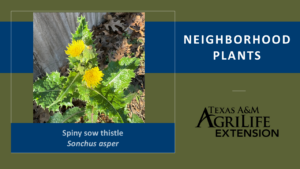 Spiny Sow Thistle – a non-native annual forb that is found growing across neighborhoods and rangelands. Spiny sow thistle looks very similar to common sow thistle (S. oleraceus), but spiny sow thistle has rounded basal leaf lobes while common sow thistle basal leaf lobes are more pointy or triangular in shape. Spiny sow thistle is a valuable food resource for many pollinators. The seeds are consumed by granivorous birds- such as gold finches. The plant is browsed on by livestock and wildlife, especially when it is young and tender.
Spiny Sow Thistle – a non-native annual forb that is found growing across neighborhoods and rangelands. Spiny sow thistle looks very similar to common sow thistle (S. oleraceus), but spiny sow thistle has rounded basal leaf lobes while common sow thistle basal leaf lobes are more pointy or triangular in shape. Spiny sow thistle is a valuable food resource for many pollinators. The seeds are consumed by granivorous birds- such as gold finches. The plant is browsed on by livestock and wildlife, especially when it is young and tender.
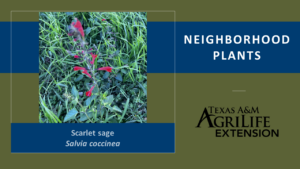 Scarlet Sage – a native forb that is found across neighborhoods and rangelands. Scarlet sage grows 30-40 inches in height and has one-inch-long flowers that attract pollinators, such as hummingbirds and butterflies. The flowers can be in bloom any time of the year and this native plant grows well in partial shade or full sun.
Scarlet Sage – a native forb that is found across neighborhoods and rangelands. Scarlet sage grows 30-40 inches in height and has one-inch-long flowers that attract pollinators, such as hummingbirds and butterflies. The flowers can be in bloom any time of the year and this native plant grows well in partial shade or full sun.
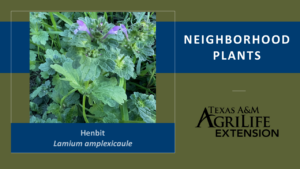 Henbit – a non-native forb that is found across neighborhoods and rangelands. Henbit is a cool season annual that blooms late fall through the winter. The flowers are a nectar source for pollinators, such as honeybees and hummingbirds. Chickens were observed eating this plant and liking it, so it was named henbit.
Henbit – a non-native forb that is found across neighborhoods and rangelands. Henbit is a cool season annual that blooms late fall through the winter. The flowers are a nectar source for pollinators, such as honeybees and hummingbirds. Chickens were observed eating this plant and liking it, so it was named henbit.
FEBRUARY
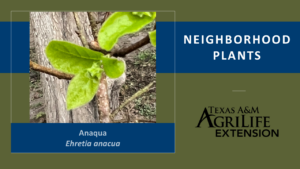 Anaqua or Sandpaper-tree – a native shrub or tree that is found growing across neighborhoods and rangelands. Anaqua (syn. Anacua) benefits many species, including humans. Humans use the wood for fenceposts and tool handles and often use this native tree as a landscape tree. The many small, white flowers attract an abundance of pollinators. Many birds and mammals, like coyotes and raccoons, consume the fruits. White-tail deer will sometimes browse on the leaves.
Anaqua or Sandpaper-tree – a native shrub or tree that is found growing across neighborhoods and rangelands. Anaqua (syn. Anacua) benefits many species, including humans. Humans use the wood for fenceposts and tool handles and often use this native tree as a landscape tree. The many small, white flowers attract an abundance of pollinators. Many birds and mammals, like coyotes and raccoons, consume the fruits. White-tail deer will sometimes browse on the leaves.
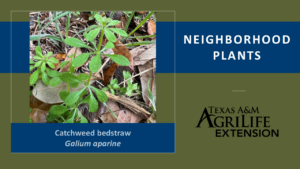 Catchweed Bedstraw – a native forb that is found growing across neighborhoods and rangelands. Catchweed bedstraw is also commonly called goose grass because geese eat the seeds, in addition to other birds such as wild turkeys and prairie-chickens. Large mammals and livestock will eat bedstraw, but it is a small component of their diets. Some small pollinators will visit the tiny flowers.
Catchweed Bedstraw – a native forb that is found growing across neighborhoods and rangelands. Catchweed bedstraw is also commonly called goose grass because geese eat the seeds, in addition to other birds such as wild turkeys and prairie-chickens. Large mammals and livestock will eat bedstraw, but it is a small component of their diets. Some small pollinators will visit the tiny flowers.
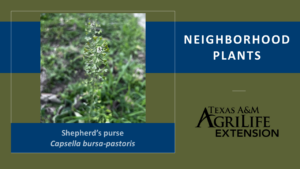 Shepherd’s Purse – a non-native forb that is found across neighborhoods and rangelands. Shepherd’s purse is an annual with heart-shaped fruits or seed pods. The fruits produce a chemical that attracts tiny organisms, then the plant digests the tiny critters. Shepherd’s purse is a carnivorous plant. It has been reported that when the seeds are placed in water, they attract mosquitoes and the mosquitoes’ mouths get stuck in the gummy substance produced by the seeds. The seeds will also release a substance that is toxic to mosquito larvae. The flowers provide nectar to pollinators and the leaves and stems are browsed by deer.
Shepherd’s Purse – a non-native forb that is found across neighborhoods and rangelands. Shepherd’s purse is an annual with heart-shaped fruits or seed pods. The fruits produce a chemical that attracts tiny organisms, then the plant digests the tiny critters. Shepherd’s purse is a carnivorous plant. It has been reported that when the seeds are placed in water, they attract mosquitoes and the mosquitoes’ mouths get stuck in the gummy substance produced by the seeds. The seeds will also release a substance that is toxic to mosquito larvae. The flowers provide nectar to pollinators and the leaves and stems are browsed by deer.
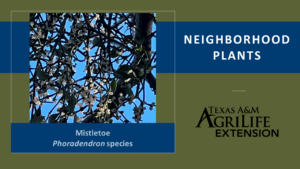 Mistletoe – a native shrub that is found growing high upon tree branches across neighborhoods and rangelands. There are seven species of mistletoe in Texas, but it has been reported that Christmas mistletoe is the only species that grows in deep South Texas. Mistletoe is a semi-parasitic plant that gets its water and some nutrients from the host tree it grows on. Plants are either male or female. Both have tiny yellow flowers, but only the female flowers turn into small white berries. Christmas mistletoe is a host plant for the Great Purple Hairstreak butterfly, and it is used as a food resource for some birds and mammals.
Mistletoe – a native shrub that is found growing high upon tree branches across neighborhoods and rangelands. There are seven species of mistletoe in Texas, but it has been reported that Christmas mistletoe is the only species that grows in deep South Texas. Mistletoe is a semi-parasitic plant that gets its water and some nutrients from the host tree it grows on. Plants are either male or female. Both have tiny yellow flowers, but only the female flowers turn into small white berries. Christmas mistletoe is a host plant for the Great Purple Hairstreak butterfly, and it is used as a food resource for some birds and mammals.
MARCH
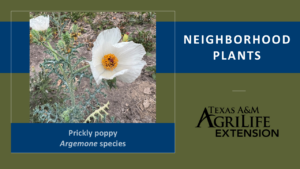 Prickly Poppy – a native forb that is found growing across neighborhoods and rangelands. There are many species of prickly poppy that are native to Texas. Flower petals colors can be deceptive in distinguishing the species. For example, the flower petals of red poppy (Argemone sanguinea) may be red, pink, purple, or white. Prickly poppies are a valuable resource for pollinators.
Prickly Poppy – a native forb that is found growing across neighborhoods and rangelands. There are many species of prickly poppy that are native to Texas. Flower petals colors can be deceptive in distinguishing the species. For example, the flower petals of red poppy (Argemone sanguinea) may be red, pink, purple, or white. Prickly poppies are a valuable resource for pollinators.
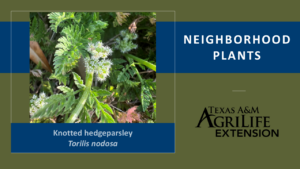 Knotted Hedgeparsley – a non-native forb growing across neighborhoods and rangelands. The barbed covered fruits are a key distinguishing feature of this plant. Pollinators visit the flowers, and the fruits are eaten by some birds and small mammals.
Knotted Hedgeparsley – a non-native forb growing across neighborhoods and rangelands. The barbed covered fruits are a key distinguishing feature of this plant. Pollinators visit the flowers, and the fruits are eaten by some birds and small mammals.
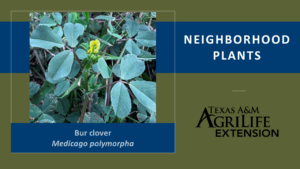 Bur Clover– a non-native legume that is found growing across neighborhoods and rangelands. Bur clover looks like an ordinary clover, but upon closer inspection, you’ll see the bur-like prickly fruits. After touching bur clover, it has been advised to wash your hands before touching your eyes because eye irritation has been reported after people touch the plant and then their eyes. Bur clover is beneficial. It is used for soil restoration because it provides organic matter in well drained soils and adds nitrogen to the soil yielding approximately 50-125 pounds of nitrogen per acre. It has a high protein content, so it is mixed with oats and wheat to provide livestock forage during winter and spring. As with all legumes, keep an eye on livestock for any signs of bloat. The dry burs are readily eaten by deer and quail. The flowers provide nectar to a variety of pollinators.
Bur Clover– a non-native legume that is found growing across neighborhoods and rangelands. Bur clover looks like an ordinary clover, but upon closer inspection, you’ll see the bur-like prickly fruits. After touching bur clover, it has been advised to wash your hands before touching your eyes because eye irritation has been reported after people touch the plant and then their eyes. Bur clover is beneficial. It is used for soil restoration because it provides organic matter in well drained soils and adds nitrogen to the soil yielding approximately 50-125 pounds of nitrogen per acre. It has a high protein content, so it is mixed with oats and wheat to provide livestock forage during winter and spring. As with all legumes, keep an eye on livestock for any signs of bloat. The dry burs are readily eaten by deer and quail. The flowers provide nectar to a variety of pollinators.
Sorrel – a small native forb that is found growing across neighborhoods and rangelands. It is estimated that there are 10-12 different sorrel species that grow in Texas. Sorrels are low growing plants that look like a bunch or bouquet of clover leaves. It is commonly called a shamrock plant. Each leaf is made up of three heart-shaped leaflets. Sorrels provide forage for various wildlife species, including pollinators, birds, and mammals. In North America, Oxalis species poisoning is rarely a problem for livestock, but has been associated with livestock poisoning in Australia.
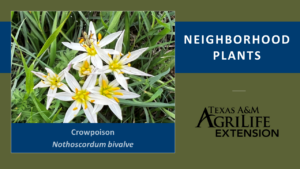 Crowpoison – a native forb that grows in neighborhoods and rangelands in many Texas counties. Crowpoison is one of the first plants to emerge and flower. In fact, it may be seen blooming almost every month of the year. So it provides an important nectar source for insects, bees, and butterflies.
Crowpoison – a native forb that grows in neighborhoods and rangelands in many Texas counties. Crowpoison is one of the first plants to emerge and flower. In fact, it may be seen blooming almost every month of the year. So it provides an important nectar source for insects, bees, and butterflies.
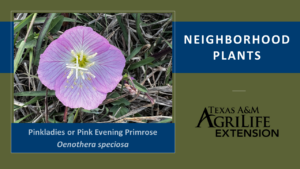 Pinkladies or Pink Evening Primrose – a native forb that grows in neighborhoods and rangelands in many Texas counties. The flowers of Pinkladies provide nectar to bees and butterflies. The seeds of Pinkladies are eaten by birds and small mammals.
Pinkladies or Pink Evening Primrose – a native forb that grows in neighborhoods and rangelands in many Texas counties. The flowers of Pinkladies provide nectar to bees and butterflies. The seeds of Pinkladies are eaten by birds and small mammals.
APRIL
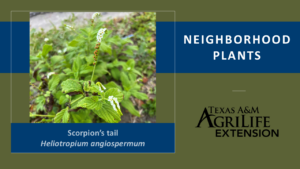 Scorpions Tail – a native forb or subshrub growing across neighborhoods and rangelands. This plant has the ability to bloom anytime of the year. Thus, it provides a valuable food resource for pollinators. The seeds are consumed by some birds.
Scorpions Tail – a native forb or subshrub growing across neighborhoods and rangelands. This plant has the ability to bloom anytime of the year. Thus, it provides a valuable food resource for pollinators. The seeds are consumed by some birds.
 Herb of Grace – a native forb growing across neighborhoods and rangelands. This plant is found in areas where water has been standing for a long time. Another common name is coastal water hyssop. It provides a valuable food resource for pollinators.
Herb of Grace – a native forb growing across neighborhoods and rangelands. This plant is found in areas where water has been standing for a long time. Another common name is coastal water hyssop. It provides a valuable food resource for pollinators.
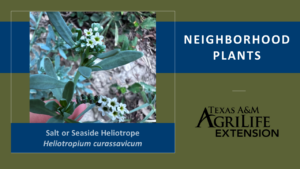 Salt or Seaside Heliotrope – a small native succulent forb that is found growing across neighborhoods and rangelands. The fleshy or succulent leaves and stems sets this heliotrope apart from other species of heliotropes. It is common in coastal areas, but also grows inland on soils that are ‘salty’ and in sidewalk cracks. The leaves are bluish-green, and the flowers are mostly white, sometimes have a purple-tinge, with yellow centers. Salt heliotrope provides forage for quail and pollinators.
Salt or Seaside Heliotrope – a small native succulent forb that is found growing across neighborhoods and rangelands. The fleshy or succulent leaves and stems sets this heliotrope apart from other species of heliotropes. It is common in coastal areas, but also grows inland on soils that are ‘salty’ and in sidewalk cracks. The leaves are bluish-green, and the flowers are mostly white, sometimes have a purple-tinge, with yellow centers. Salt heliotrope provides forage for quail and pollinators.
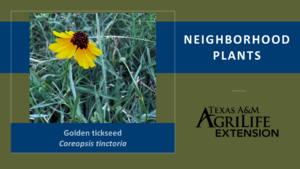 Golden Tickseed – also called Goldenwave or Plains Coreopsis, an annual native forb that is found growing across neighborhoods and rangelands. This golden tickseed (Coreopsis tinctoria) has hairless stems. There is another golden tickseed (Coreopsis basalis) that looks almost identical, but it has hairy stems. The flowers may have different color patterns, with some having a wider reddish band around the base of the yellow ray flowers – ray flowers look like flower petals. This golden tickseed is one of the most commonly encountered coreopsis species –growing in ditches and at the edges of wet areas. Sometimes, deer will eat the leaves. The flowers provide food for a variety of pollinators and several bird species eat the seeds.
Golden Tickseed – also called Goldenwave or Plains Coreopsis, an annual native forb that is found growing across neighborhoods and rangelands. This golden tickseed (Coreopsis tinctoria) has hairless stems. There is another golden tickseed (Coreopsis basalis) that looks almost identical, but it has hairy stems. The flowers may have different color patterns, with some having a wider reddish band around the base of the yellow ray flowers – ray flowers look like flower petals. This golden tickseed is one of the most commonly encountered coreopsis species –growing in ditches and at the edges of wet areas. Sometimes, deer will eat the leaves. The flowers provide food for a variety of pollinators and several bird species eat the seeds.
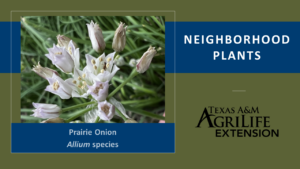 Prairie Onion – a native forb that grows in neighborhoods and rangelands in most Texas counties. The flowers of Prairie Onion can be white to pink in color and provide nectar to pollinators. Prairie Onion has look-a-likes, such as crowpoison.
Prairie Onion – a native forb that grows in neighborhoods and rangelands in most Texas counties. The flowers of Prairie Onion can be white to pink in color and provide nectar to pollinators. Prairie Onion has look-a-likes, such as crowpoison.
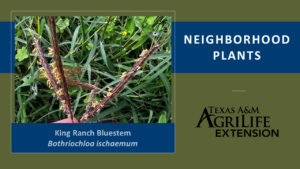 King Ranch Bluestem – a non-native, invasive grass that grows in neighborhoods and rangelands on over 4-million acres of TX lands. The new spring growth can provide forage for livestock, or it can be cut and used for hay. King Ranch bluestem looks very similar to Kleberg bluestem. Kleberg bluestem grows in Central and South Texas along the Gulf, growing best on loamy to clay soils, while KR bluestem is more widespread. KR bluestem is the main grass seen along TX roadsides.
King Ranch Bluestem – a non-native, invasive grass that grows in neighborhoods and rangelands on over 4-million acres of TX lands. The new spring growth can provide forage for livestock, or it can be cut and used for hay. King Ranch bluestem looks very similar to Kleberg bluestem. Kleberg bluestem grows in Central and South Texas along the Gulf, growing best on loamy to clay soils, while KR bluestem is more widespread. KR bluestem is the main grass seen along TX roadsides.
MAY
 Orange Zexmenia – a native shrub growing across neighborhoods and rangelands. This plant keeps blooming most of the year. Thus, it provides a valuable food resource for pollinators. It is drought tolerant, making it a reliable garden ornamental.
Orange Zexmenia – a native shrub growing across neighborhoods and rangelands. This plant keeps blooming most of the year. Thus, it provides a valuable food resource for pollinators. It is drought tolerant, making it a reliable garden ornamental.
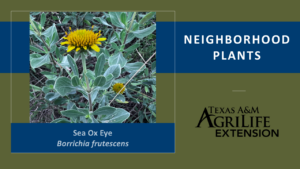 Sea Ox Eye – also called Sea Daisy, a native perennial subshrub that is found growing across neighborhoods and rangelands. Sea ox eye grows in ‘salty’ soils. The daisy-like flowers have yellow ray and disk flowers, and the disk flowers have many sharp-pointed scales. Sea ox eye flowers provide nectar to many bees and butterflies and seeds to birds. They can grow up to 32-inches tall, so they also provide cover.
Sea Ox Eye – also called Sea Daisy, a native perennial subshrub that is found growing across neighborhoods and rangelands. Sea ox eye grows in ‘salty’ soils. The daisy-like flowers have yellow ray and disk flowers, and the disk flowers have many sharp-pointed scales. Sea ox eye flowers provide nectar to many bees and butterflies and seeds to birds. They can grow up to 32-inches tall, so they also provide cover.
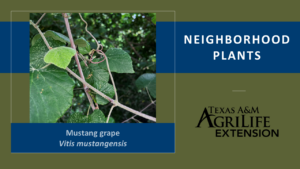 Mustang Grape – a native perennial vine that is found growing across neighborhoods and rangelands. Mustang grapes are easily recognized by the white, velvety surface on the underside of the leaf. The fruit of mustang grape provides forage for birds and small mammals, and is popular with people that make homemade wines.
Mustang Grape – a native perennial vine that is found growing across neighborhoods and rangelands. Mustang grapes are easily recognized by the white, velvety surface on the underside of the leaf. The fruit of mustang grape provides forage for birds and small mammals, and is popular with people that make homemade wines.
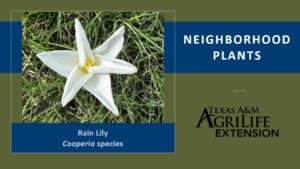 Rain Lily – a native forb that blooms for a few days after rain in neighborhoods and rangelands. The fragrant flower attracts bees and butterflies. There are two rain lily species that look very similar: (1) Hill Country Rain Lily (Cooperia pedunculata) and (2) Evening Rain Lily (Cooperia drummondii). Both can flower in the spring, but Evening Rain Lily most frequently flowers in the late summer and fall. The length of the perianth, a protective cover enclosing the reproductive organs, distinguishes the two species.
Rain Lily – a native forb that blooms for a few days after rain in neighborhoods and rangelands. The fragrant flower attracts bees and butterflies. There are two rain lily species that look very similar: (1) Hill Country Rain Lily (Cooperia pedunculata) and (2) Evening Rain Lily (Cooperia drummondii). Both can flower in the spring, but Evening Rain Lily most frequently flowers in the late summer and fall. The length of the perianth, a protective cover enclosing the reproductive organs, distinguishes the two species.
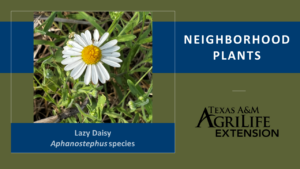 Lazy Daisy – a native forb that blooms in the spring and summer across neighborhoods and rangelands. The flowers attract pollinators. There are many lazy daisy species that look very similar. For example: Lazy Daisy (Aphanostephus ramosissimus var. ramosissimus) looks similar to Aphanostephus skirrhobasis and A. skirrhobasis has several varieties – such as Kidder’s Lazy Daisy and Coastal Lazy Daisy. The small details on the flower parts distinguish the species and often require a magnifying glass to see.
Lazy Daisy – a native forb that blooms in the spring and summer across neighborhoods and rangelands. The flowers attract pollinators. There are many lazy daisy species that look very similar. For example: Lazy Daisy (Aphanostephus ramosissimus var. ramosissimus) looks similar to Aphanostephus skirrhobasis and A. skirrhobasis has several varieties – such as Kidder’s Lazy Daisy and Coastal Lazy Daisy. The small details on the flower parts distinguish the species and often require a magnifying glass to see.
JUNE
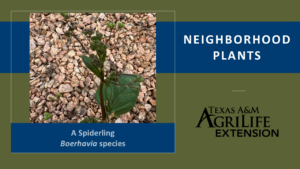 Spiderling Species – a native forbs growing across neighborhoods and rangelands. There are several species of spiderlings in Texas. Spiderlings may be difficult to distinguish because they are polymorphic, which means they can have many different forms. This plant is valuable as a food resource for many species, including pollinators, wildlife, and livestock.
Spiderling Species – a native forbs growing across neighborhoods and rangelands. There are several species of spiderlings in Texas. Spiderlings may be difficult to distinguish because they are polymorphic, which means they can have many different forms. This plant is valuable as a food resource for many species, including pollinators, wildlife, and livestock.
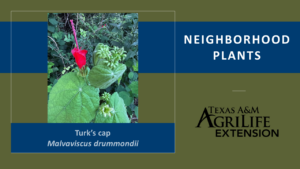 Turk’s Cap – also called wax mallow, a native perennial subshrub/shrub that is found growing across neighborhoods and rangelands. Turk’s cap, Malvaviscus drummondii or M. arboreus var. drummondii, is very similar to the cultivated variety of turk’s cap (M. Penduliflorus) that is often found in neighborhood gardens. The biggest difference between the native and the garden varieties can be seen at the base of the leaves where the leaf stem meets the leaf. The leaf base of the native turk’s cap is heart shaped, while the garden variety has a rounded leaf base. The native turk’s cap produces a fruit that is eaten by wildlife. The flowers provide nectar to hummingbirds and butterflies. Turk’s cap is also a host plant for larvae of the Mallow Scrub-hairstreak and Turk’s Cap White-skipper butterflies.
Turk’s Cap – also called wax mallow, a native perennial subshrub/shrub that is found growing across neighborhoods and rangelands. Turk’s cap, Malvaviscus drummondii or M. arboreus var. drummondii, is very similar to the cultivated variety of turk’s cap (M. Penduliflorus) that is often found in neighborhood gardens. The biggest difference between the native and the garden varieties can be seen at the base of the leaves where the leaf stem meets the leaf. The leaf base of the native turk’s cap is heart shaped, while the garden variety has a rounded leaf base. The native turk’s cap produces a fruit that is eaten by wildlife. The flowers provide nectar to hummingbirds and butterflies. Turk’s cap is also a host plant for larvae of the Mallow Scrub-hairstreak and Turk’s Cap White-skipper butterflies.
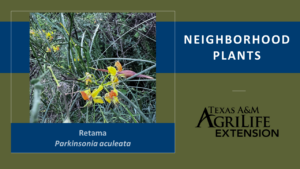 Retama – also called paloverde, a native perennial shrub/tree that is found growing across neighborhoods and rangelands. One of the most distinguishing features of retama is the green branches. Be careful if you investigate the branches closely as they have many curved thorns along them. During drought, the leaves often fall off and the green branches will become a brighter shade of green because the branches take on the role of photosynthesis. It is a useful plant for many wildlife and livestock species. The flowers provide a source of nectar for pollinators, the seeds are consumed by small mammals and birds, the foliage and pods are eaten by wildlife and livestock during times when other foods are less available. It also provides nesting sites and cover for wildlife.
Retama – also called paloverde, a native perennial shrub/tree that is found growing across neighborhoods and rangelands. One of the most distinguishing features of retama is the green branches. Be careful if you investigate the branches closely as they have many curved thorns along them. During drought, the leaves often fall off and the green branches will become a brighter shade of green because the branches take on the role of photosynthesis. It is a useful plant for many wildlife and livestock species. The flowers provide a source of nectar for pollinators, the seeds are consumed by small mammals and birds, the foliage and pods are eaten by wildlife and livestock during times when other foods are less available. It also provides nesting sites and cover for wildlife.
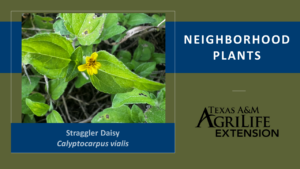 Straggler Daisy – a forb that may bloom all year long across neighborhoods and rangelands. Some sources report this forb is native to South Texas, while other sources state it is not native. The tiny flowers attract small pollinators, like skipper and sulfur butterflies. The leaves can provide a food source for animals. Straggler daisies grow in shady and sunny areas and are tolerant to moderate foot traffic. It can cover a lot of ground with its prostrate growth form.
Straggler Daisy – a forb that may bloom all year long across neighborhoods and rangelands. Some sources report this forb is native to South Texas, while other sources state it is not native. The tiny flowers attract small pollinators, like skipper and sulfur butterflies. The leaves can provide a food source for animals. Straggler daisies grow in shady and sunny areas and are tolerant to moderate foot traffic. It can cover a lot of ground with its prostrate growth form.
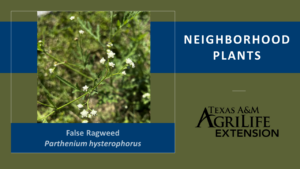 False Ragweed – a non-native weed that blooms spring, summer and fall across neighborhoods and rangelands. This tiny weed is often not welcomed and is listed in the top 100 most invasive plants in the world. While this plant can cause allergy issues for some, the plant is being studied for some of its potential medicinal uses and its ability to ‘clean’ the environment by removing heavy metals.
False Ragweed – a non-native weed that blooms spring, summer and fall across neighborhoods and rangelands. This tiny weed is often not welcomed and is listed in the top 100 most invasive plants in the world. While this plant can cause allergy issues for some, the plant is being studied for some of its potential medicinal uses and its ability to ‘clean’ the environment by removing heavy metals.
JULY
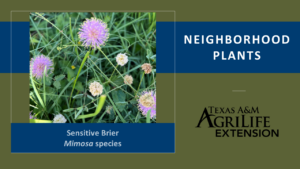 Sensitive Brier – a native perennial forb that is found sprawling across neighborhoods and rangelands. One of the most distinguishing features is the numerous pink pom-pom-like flowers. Be careful if you investigate the flowers or sensitive leaves, as this plant has many thorns. Sensitive brier is a useful plant for many wildlife and livestock species. The flowers provide nectar for pollinators, and the foliage is eaten by wildlife and livestock.
Sensitive Brier – a native perennial forb that is found sprawling across neighborhoods and rangelands. One of the most distinguishing features is the numerous pink pom-pom-like flowers. Be careful if you investigate the flowers or sensitive leaves, as this plant has many thorns. Sensitive brier is a useful plant for many wildlife and livestock species. The flowers provide nectar for pollinators, and the foliage is eaten by wildlife and livestock.
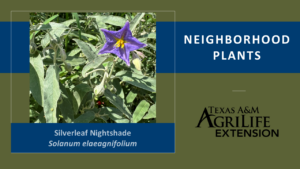 Silverleaf Nightshade – a native perennial forb that is found across neighborhoods and rangelands. One of the most distinguishing features are the long, narrow leaves with wavy edges. Be careful if you investigate the plant, as it may have many thorns. Silverleaf nightshade provides a nectar source for pollinators and some birds do eat the fruits. However, all parts of this plant do contain toxins, so it is rated as poor forage for livestock and wildlife.
Silverleaf Nightshade – a native perennial forb that is found across neighborhoods and rangelands. One of the most distinguishing features are the long, narrow leaves with wavy edges. Be careful if you investigate the plant, as it may have many thorns. Silverleaf nightshade provides a nectar source for pollinators and some birds do eat the fruits. However, all parts of this plant do contain toxins, so it is rated as poor forage for livestock and wildlife.
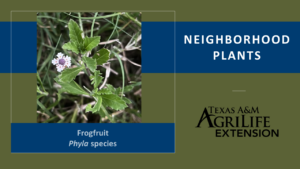 Frogfruit – a native weed that blooms spring, summer and fall across neighborhoods and rangelands. Frogfruit is a low growing plant that makes excellent ground cover and attracts native pollinators. There are several native species of frogfruit, such as Texas frogfruit (Phyla nodiflora) and Lanceleaf frogfruit (Phyla lanceolata). Texas frogfruit leaves are wider at the tip and its serrated leaf edges are mostly around the upper part of the leaf and tip. Lanceleaf frogfruit leaves are often widest near the middle and the serrated leaf edges extend from the tip to below the middle of the leaf. These two closely related frogfruit plants can also form hybrids, which sometimes makes it difficult to identify the frogfruit to species in the field.
Frogfruit – a native weed that blooms spring, summer and fall across neighborhoods and rangelands. Frogfruit is a low growing plant that makes excellent ground cover and attracts native pollinators. There are several native species of frogfruit, such as Texas frogfruit (Phyla nodiflora) and Lanceleaf frogfruit (Phyla lanceolata). Texas frogfruit leaves are wider at the tip and its serrated leaf edges are mostly around the upper part of the leaf and tip. Lanceleaf frogfruit leaves are often widest near the middle and the serrated leaf edges extend from the tip to below the middle of the leaf. These two closely related frogfruit plants can also form hybrids, which sometimes makes it difficult to identify the frogfruit to species in the field.
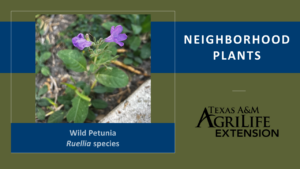 Wild Petunia – a native weed that is in bloom this time of year, summer through early fall, across neighborhoods and rangelands. Wild petunia is a low growing plant that attracts hummingbirds and other native pollinators. There are several native species of wild petunia, such as Corzo’s Wild Petunia (R. corzoi), Rio Grande Wild Petunia (R. davisiorum), and not to mention the several varieties of the Carolina Wild Petunia (R. caroliniensis). With so many look-a-likes- it can be difficult to narrow down the exact species of wild petunia in the field. However, the hummingbirds and native pollinators will enjoy them all about the same.
Wild Petunia – a native weed that is in bloom this time of year, summer through early fall, across neighborhoods and rangelands. Wild petunia is a low growing plant that attracts hummingbirds and other native pollinators. There are several native species of wild petunia, such as Corzo’s Wild Petunia (R. corzoi), Rio Grande Wild Petunia (R. davisiorum), and not to mention the several varieties of the Carolina Wild Petunia (R. caroliniensis). With so many look-a-likes- it can be difficult to narrow down the exact species of wild petunia in the field. However, the hummingbirds and native pollinators will enjoy them all about the same.
AUGUST
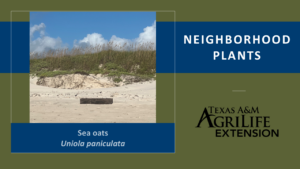 Sea Oats – a native perennial grass that is found across beach neighborhoods and rangelands. One of the most distinguishing features are the large seed heads with flat spikelets. Seeds are inside the spikelets when they turn brown. Sea oats can grow up to 6-8-feet in height and their roots can extend 40-feet down. The massive root system helps to stabilize dunes on beaches. The large grass provides cover for small animals. The seeds provide food for birds and rodents and some butterflies lay their eggs in the leaves.
Sea Oats – a native perennial grass that is found across beach neighborhoods and rangelands. One of the most distinguishing features are the large seed heads with flat spikelets. Seeds are inside the spikelets when they turn brown. Sea oats can grow up to 6-8-feet in height and their roots can extend 40-feet down. The massive root system helps to stabilize dunes on beaches. The large grass provides cover for small animals. The seeds provide food for birds and rodents and some butterflies lay their eggs in the leaves.
Beach Croton – a native perennial forb or subshrub that is found across beach neighborhoods and rangelands. Distinguishing features include the brown stems and veins and the dots on the underside of the leaves. Beach croton may be in bloom anytime of the year and it produces a 3-seeded fruit. Because it is a native plant that grows well in sandy soils, it helps to form and stabilize dunes in coastal areas. It also provides shelter for small animals.
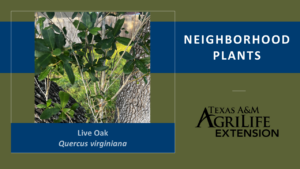 Live Oak – a native tree that provides excellent shade across neighborhoods and rangelands. Live oak trees have a massive trunk that supports a large canopy of branches and leaves. It’s almost an evergreen tree, but not quite. Live oak trees do not lose their leaves in the fall. Rather, the leaves remain on the tree through the winter and drop off the tree during the spring right before the new leaves emerge. Some individual live oak trees can grow massive amounts of suckers from the roots. Sometimes it is so thick that the root suckers look like a groundcover. These root suckers are attached to the roots of the main tree, so careful maintenance is required. Here’s a couple of links to articles to learn more about live oak and some maintenance tips if the live oak tree in your yard puts up a lot of root suckers: https://agrilifetoday.tamu.edu/2007/0… https://fbmg.org/files/2020/03/Oak-Tr….
Live Oak – a native tree that provides excellent shade across neighborhoods and rangelands. Live oak trees have a massive trunk that supports a large canopy of branches and leaves. It’s almost an evergreen tree, but not quite. Live oak trees do not lose their leaves in the fall. Rather, the leaves remain on the tree through the winter and drop off the tree during the spring right before the new leaves emerge. Some individual live oak trees can grow massive amounts of suckers from the roots. Sometimes it is so thick that the root suckers look like a groundcover. These root suckers are attached to the roots of the main tree, so careful maintenance is required. Here’s a couple of links to articles to learn more about live oak and some maintenance tips if the live oak tree in your yard puts up a lot of root suckers: https://agrilifetoday.tamu.edu/2007/0… https://fbmg.org/files/2020/03/Oak-Tr….
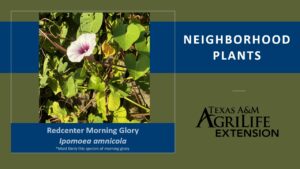 Morning Glories – an annual vine that does great in dry soils across neighborhoods and rangelands. There’s more than 1,000 different species of morning glories (Ipomoea species). The morning glory in the video is most likely redcenter morning glory (Ipomoea amnicola), an introduced plant. However, there are several native species of morning glories in Texas, such as Blue Morning Glory (Ipomoea lindheimeri). Many morning glories have heart shaped leaves and trumpet shaped flowers that come in a variety of colors. Morning glories are easily grown from seeds and they’re pretty hardy- growing well in poor, dry soils. This makes morning glories a great first starter plant in a garden for a youngster.
Morning Glories – an annual vine that does great in dry soils across neighborhoods and rangelands. There’s more than 1,000 different species of morning glories (Ipomoea species). The morning glory in the video is most likely redcenter morning glory (Ipomoea amnicola), an introduced plant. However, there are several native species of morning glories in Texas, such as Blue Morning Glory (Ipomoea lindheimeri). Many morning glories have heart shaped leaves and trumpet shaped flowers that come in a variety of colors. Morning glories are easily grown from seeds and they’re pretty hardy- growing well in poor, dry soils. This makes morning glories a great first starter plant in a garden for a youngster.
SEPTEMBER
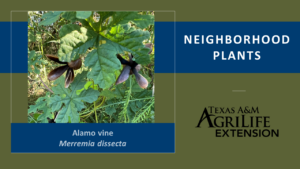 Alamo Vine – a native perennial vine that is found across growing neighborhoods and rangelands. Distinguishing features include the deeply lobed palmate leaves, and the mature seed capsules that look like flowers. The flower, not shown in the video, looks like a morning glory flower. The flower provides nectar and pollen for pollinators. It is a larval host for the Painted Crescent butterfly. It also provides cover for small animals.
Alamo Vine – a native perennial vine that is found across growing neighborhoods and rangelands. Distinguishing features include the deeply lobed palmate leaves, and the mature seed capsules that look like flowers. The flower, not shown in the video, looks like a morning glory flower. The flower provides nectar and pollen for pollinators. It is a larval host for the Painted Crescent butterfly. It also provides cover for small animals.
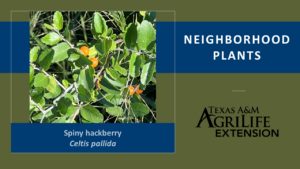 Spiny Hackberry – or granjeno, a native perennial shrub that is found growing across neighborhoods and rangelands. Distinguishing features include the toothed leaf tips, light-colored bark, and small orange fruits (drupes) that can remain attached to the stem long after the leaves drop. The flowers provide nectar for pollinators, and it is a larval host plant for the American Snout butterfly. The fruits or drupes provide forage for birds and small mammals. It also provides cover for wildlife species.
Spiny Hackberry – or granjeno, a native perennial shrub that is found growing across neighborhoods and rangelands. Distinguishing features include the toothed leaf tips, light-colored bark, and small orange fruits (drupes) that can remain attached to the stem long after the leaves drop. The flowers provide nectar for pollinators, and it is a larval host plant for the American Snout butterfly. The fruits or drupes provide forage for birds and small mammals. It also provides cover for wildlife species.
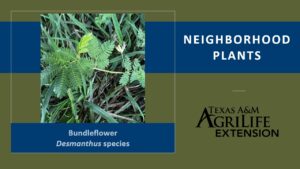 Bundleflower – a forb that grows creeping along the ground like a vine across neighborhoods and rangelands. Bundleflowers are a great source of food for many animals, including bobwhite quail, turkey, white-tailed deer, and livestock.
Bundleflower – a forb that grows creeping along the ground like a vine across neighborhoods and rangelands. Bundleflowers are a great source of food for many animals, including bobwhite quail, turkey, white-tailed deer, and livestock.
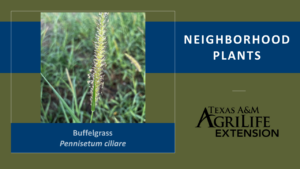 Buffelgrass – a non-native, invasive grass that is found across neighborhoods and rangelands. Buffelgrass provides a good forage for livestock, but it also forms monocultures that reduce diversity. Check out these links to our recent publications on buffelgrass: exploring the pros and cons and range of management options (https://agrilifeextension.tamu.edu/as…) a plant identification and quick reference management guide (https://agrilifeextension.tamu.edu/as….
Buffelgrass – a non-native, invasive grass that is found across neighborhoods and rangelands. Buffelgrass provides a good forage for livestock, but it also forms monocultures that reduce diversity. Check out these links to our recent publications on buffelgrass: exploring the pros and cons and range of management options (https://agrilifeextension.tamu.edu/as…) a plant identification and quick reference management guide (https://agrilifeextension.tamu.edu/as….
OCTOBER
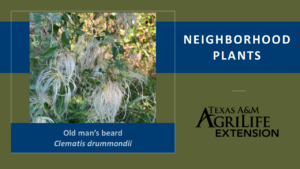 Old Man’s Beard – a native perennial vine that is found growing across neighborhoods and rangelands. The most distinguishing feature is the fruits that look like white beards. Sometimes cattle will eat the leaves. The leaves are an important food resource for white-tailed deer and are also eaten by turkeys. The seeds provide food for birds. The flowers are a nectar resource for many pollinators. Old man’s beard is the host plant for the dusky metalmark butterfly. Thick stands of old man’s beard provide cover for wildlife and nesting sites for birds.
Old Man’s Beard – a native perennial vine that is found growing across neighborhoods and rangelands. The most distinguishing feature is the fruits that look like white beards. Sometimes cattle will eat the leaves. The leaves are an important food resource for white-tailed deer and are also eaten by turkeys. The seeds provide food for birds. The flowers are a nectar resource for many pollinators. Old man’s beard is the host plant for the dusky metalmark butterfly. Thick stands of old man’s beard provide cover for wildlife and nesting sites for birds.
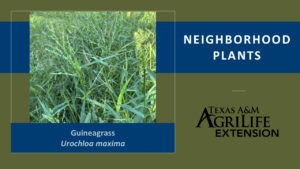 Guineagrass – a non-native perennial grass that is found growing across neighborhoods and rangelands. Most often, this grass forms a monoculture, where it becomes the dominant species, because it can inhibit other plants from growing in the area through the release of allelochemicals. It provides forage for livestock. Seeds may be eaten by bobwhite quail and other wildlife, but the formation of monocultures reduces species diversity.
Guineagrass – a non-native perennial grass that is found growing across neighborhoods and rangelands. Most often, this grass forms a monoculture, where it becomes the dominant species, because it can inhibit other plants from growing in the area through the release of allelochemicals. It provides forage for livestock. Seeds may be eaten by bobwhite quail and other wildlife, but the formation of monocultures reduces species diversity.
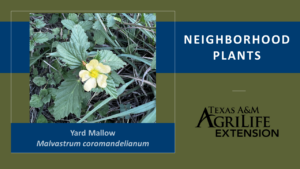 Yard Mallow – also known as Threelobe False Mallow, a non-native, forb or subshrub that is found across neighborhoods and rangelands. In disturbed areas, such as a frequently mowed lawn, yard mallow grows like a creeping forb through the vegetation and is often seen growing along with straggler daisy. When not mowed or eaten, yard mallow can grow erect, and the lower stems become woodier like a subshrub. The leaves of yard mallow provide a forage resource for rabbits, TX tortoises, deer, and cattle.
Yard Mallow – also known as Threelobe False Mallow, a non-native, forb or subshrub that is found across neighborhoods and rangelands. In disturbed areas, such as a frequently mowed lawn, yard mallow grows like a creeping forb through the vegetation and is often seen growing along with straggler daisy. When not mowed or eaten, yard mallow can grow erect, and the lower stems become woodier like a subshrub. The leaves of yard mallow provide a forage resource for rabbits, TX tortoises, deer, and cattle.
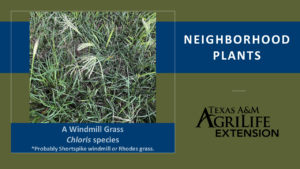 Windmill Grass – (Chloris species) found across neighborhoods and rangelands. Most windmill grasses have a seedhead that looks like a windmill. However, some plants may be hard to identify to the exact species, especially ones that can form hybrids or a plant that has characteristics of more than one species. This is one of those plants. After long discussions with many grass experts, we’ve determined that this windmill grass, or Chloris species, may be either Shortspike windmillgrass, which is a hybrid between Chloris cucullata and Chloris verticillata, or may be Rhodes grass, Chloris gayana. There are other windmill grasses that also look similar, but here’s why we think it is not these species. The awns, or stiff, hairlike bristles on the seedhead are a little longer than what we see on hooded windmill. The spikelet is smooth and does not have the hair coming off it between the awns like what we see on feather fingergrass (Chloris virgata). In the field, we cannot always identify every plant to species- some require a microscope or even more meticulous analyses. Get as close as you can, rule out what it is not, then get back on the trail.
Windmill Grass – (Chloris species) found across neighborhoods and rangelands. Most windmill grasses have a seedhead that looks like a windmill. However, some plants may be hard to identify to the exact species, especially ones that can form hybrids or a plant that has characteristics of more than one species. This is one of those plants. After long discussions with many grass experts, we’ve determined that this windmill grass, or Chloris species, may be either Shortspike windmillgrass, which is a hybrid between Chloris cucullata and Chloris verticillata, or may be Rhodes grass, Chloris gayana. There are other windmill grasses that also look similar, but here’s why we think it is not these species. The awns, or stiff, hairlike bristles on the seedhead are a little longer than what we see on hooded windmill. The spikelet is smooth and does not have the hair coming off it between the awns like what we see on feather fingergrass (Chloris virgata). In the field, we cannot always identify every plant to species- some require a microscope or even more meticulous analyses. Get as close as you can, rule out what it is not, then get back on the trail.
NOVEMBER
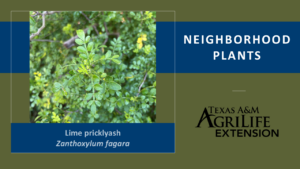 Lime Pricklyash – a native perennial shrub that is found growing across neighborhoods and rangelands. Most often, this shrub bears many sharp, cat-claw-like thorns on it, so be careful when handling the stems. The leaves provide forage for white-tailed deer. The flowers provide nectar to pollinators. It is a larval host site for the northern sicklewing and giant swallowtail butterfly. The seeds are eaten by birds, such as bobwhite quail. It also provides nesting sites for many birds and cover for many wildlife species.
Lime Pricklyash – a native perennial shrub that is found growing across neighborhoods and rangelands. Most often, this shrub bears many sharp, cat-claw-like thorns on it, so be careful when handling the stems. The leaves provide forage for white-tailed deer. The flowers provide nectar to pollinators. It is a larval host site for the northern sicklewing and giant swallowtail butterfly. The seeds are eaten by birds, such as bobwhite quail. It also provides nesting sites for many birds and cover for many wildlife species.
 Huisache – also called sweet acacia, a native perennial shrub or tree that is found growing across neighborhoods and rangelands. Most often, huisache bears paired, pin-like spines, so be careful when handling the stems. The flowers provide nectar to pollinators. The seeds pods are eaten by livestock and deer.
Huisache – also called sweet acacia, a native perennial shrub or tree that is found growing across neighborhoods and rangelands. Most often, huisache bears paired, pin-like spines, so be careful when handling the stems. The flowers provide nectar to pollinators. The seeds pods are eaten by livestock and deer.
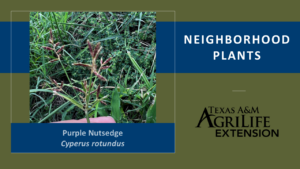 Purple Nutsedge – a non-native grass-like plant that is found across neighborhoods and rangelands. Most sedges have edges- the stem is often triangular and has edges or ridges. Also, many sedges have three leaves below the seedhead that form a triangle. Purple nutsedge is often confused with yellow nutsedge (Cyperus esculentus). Yellow nutsedge leaves have a narrow, tapered tip and are usually longer than the stem while purple nutsedge leaves form a blunt tip and are often shorter than the stem. These sedges are considered a pest because they spread easily and can be invasive. Chickens and geese at the right stocking rate have been shown to reduce infestations of purple nutsedge. Purple nutsedge has a low grazing value to wildlife and livestock.
Purple Nutsedge – a non-native grass-like plant that is found across neighborhoods and rangelands. Most sedges have edges- the stem is often triangular and has edges or ridges. Also, many sedges have three leaves below the seedhead that form a triangle. Purple nutsedge is often confused with yellow nutsedge (Cyperus esculentus). Yellow nutsedge leaves have a narrow, tapered tip and are usually longer than the stem while purple nutsedge leaves form a blunt tip and are often shorter than the stem. These sedges are considered a pest because they spread easily and can be invasive. Chickens and geese at the right stocking rate have been shown to reduce infestations of purple nutsedge. Purple nutsedge has a low grazing value to wildlife and livestock.
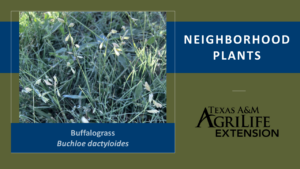 Buffalograss – a native grass that is found across neighborhoods and rangelands. Buffalograss has male plants and female plants. The male plants produce the showy seedhead with 1-4 spikes. The seedheads of the female plants are bur-like clusters that grow in the leaves. This native grass doesn’t grow very tall, making it an ideal choice for lawns. It provides good grazing for livestock. The seeds are eaten by birds. It is also used as a larval host plant for the green skipper butterfly.
Buffalograss – a native grass that is found across neighborhoods and rangelands. Buffalograss has male plants and female plants. The male plants produce the showy seedhead with 1-4 spikes. The seedheads of the female plants are bur-like clusters that grow in the leaves. This native grass doesn’t grow very tall, making it an ideal choice for lawns. It provides good grazing for livestock. The seeds are eaten by birds. It is also used as a larval host plant for the green skipper butterfly.
DECEMBER
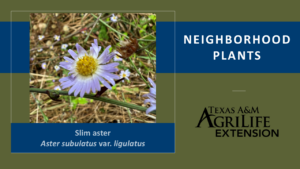 Slim Aster – a native annual forb that is found growing across neighborhoods and rangelands. This plant has many look-a-likes, but slim aster has hairless bracts that are often purple at the tips. The flowers bloom from fall through winter, so it can provide a valuable nectar resource for pollinators in TX.
Slim Aster – a native annual forb that is found growing across neighborhoods and rangelands. This plant has many look-a-likes, but slim aster has hairless bracts that are often purple at the tips. The flowers bloom from fall through winter, so it can provide a valuable nectar resource for pollinators in TX.
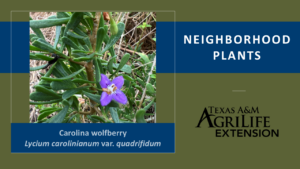 Carolina Wolfberry – also called Christmas berry, a native perennial shrub that is found growing across neighborhoods and rangelands. Carolina wolfberries are browsed on by wildlife and the flowers provide nectar to pollinators. The bright, red fruits provide food to birds and are favored by whooping cranes.
Carolina Wolfberry – also called Christmas berry, a native perennial shrub that is found growing across neighborhoods and rangelands. Carolina wolfberries are browsed on by wildlife and the flowers provide nectar to pollinators. The bright, red fruits provide food to birds and are favored by whooping cranes.
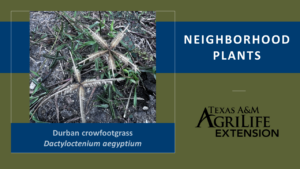 Durban Crowfootgrass – a non-native grass that is found across neighborhoods and rangelands. Durban crowfootgrass is low-growing, reaching heights around 2-feet. Durban crowfootgrass is an annual or short-lived perennial that is found in sandy fields, roadsides, and moist, disturbed sites. Cattle readily eat it, but it is considered poor value because of the limited amount of forage it produces.
Durban Crowfootgrass – a non-native grass that is found across neighborhoods and rangelands. Durban crowfootgrass is low-growing, reaching heights around 2-feet. Durban crowfootgrass is an annual or short-lived perennial that is found in sandy fields, roadsides, and moist, disturbed sites. Cattle readily eat it, but it is considered poor value because of the limited amount of forage it produces.
Hackberry Tree – a native tree that is found across neighborhoods and rangelands. The 2 most common hackberry trees in Texas are sugar hackberry and netleaf hackberry. Hackberry leaves are eaten by a variety of caterpillars. The fruits provide forage for a variety of birds, including quail and woodpeckers. While it is considered poor forage for livestock, it can provide shade.

